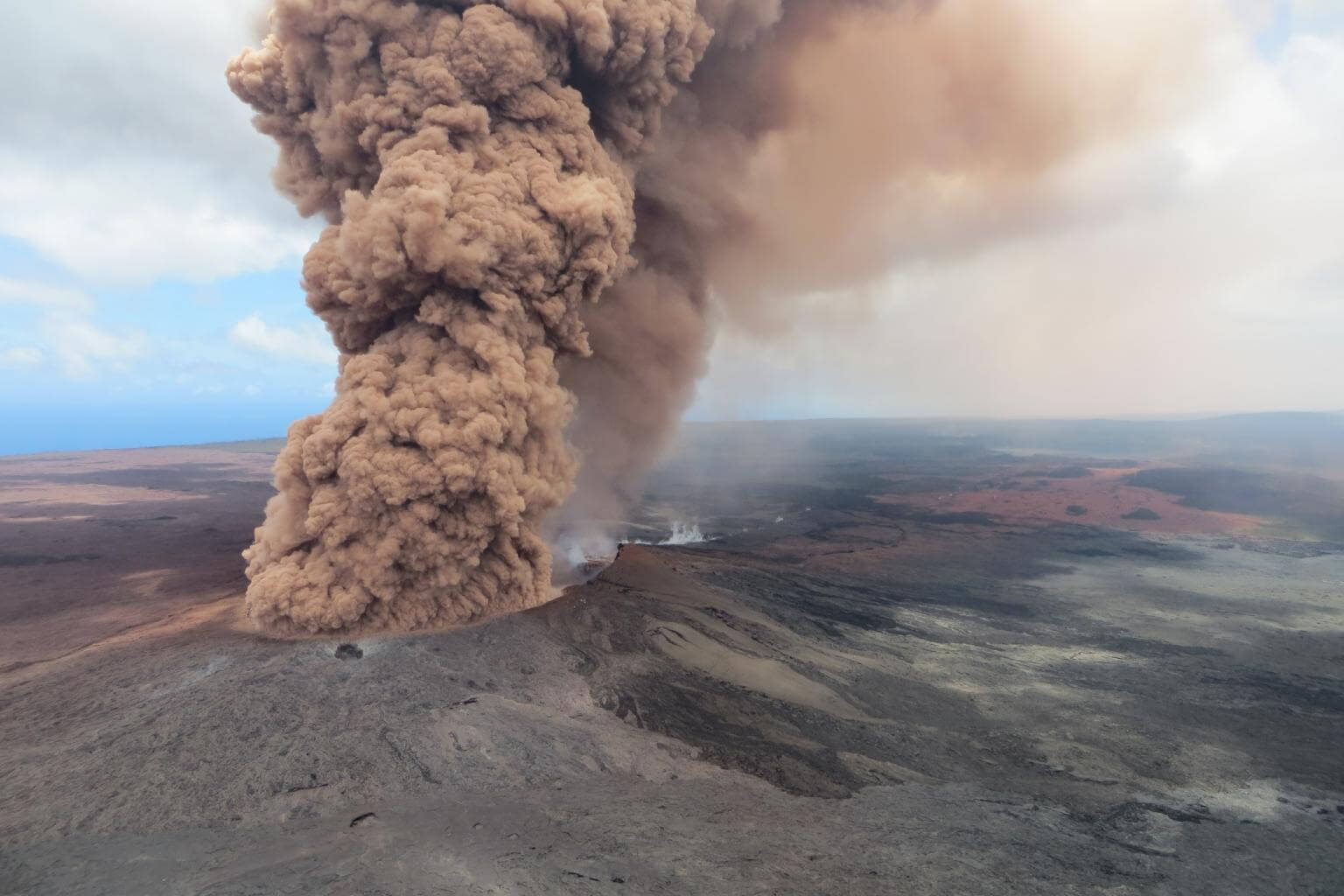Thousands flee after Hawaii quake triggers new volcano eruptions
Sign up now: Get ST's newsletters delivered to your inbox

A plume of ash rising from a crater on Mount Kilauea in Hawaii after a magnitude 6.9 earthquake struck the area on May 4, 2018.
PHOTO: EPA-EFE
Follow topic:
LEILANI ESTATES, UNITED STATES (AFP) - Thousands of people have been forced to flee after a magnitude 6.9 earthquake shook Hawaii's Big Island, triggering the collapse of a coastal cliff and prompting fresh eruptions of a volcano that has been spewing lava near residential areas.
No injuries have been reported but several homes were destroyed or badly damaged by the quake Friday (May 4), the biggest to hit the island since 1975, authorities said. It caused small sea-level changes but no tsunamis.
The US Geological Survey (USGS) said the quake struck at 12.32pm (2232 GMT) and was centred on the south flank of the Kilauea volcano, which first erupted on Thursday after a series of tremors.
A 5.7-magnitude tremor hit the island earlier on Friday. The quakes prompted the Kilauea volcano, one of five active on the island, to erupt.
The quakes temporarily cut power to thousands of households.
The Federal Aviation Administration imposed flight restrictions over the area through Monday (May 7) for all but relief operations.
The quakes triggered rock slides on trails in Hawaii Volcanoes National Park, and caused a coastal cliff to collapse into the ocean.
Officials ordered a rare closure of the park, which covers more than a tenth of the island's total surface. About 2,600 visitors were evacuated.
"It is currently not safe to be here," Park Superintendent Cindy Orlando said in a statement.
Video footage showed orange magma gushing up from cracks in the ground and snaking through a wooded area.
Molten lava could also be seen bubbling up through cracks on streets in the Leilani Estates and Lanipuna Gardens neighborhood, where residents were ordered to evacuate on Thursday.
The area is home to about 1,700 people and 770 structures, and some 10,000 people live in the broader district potentially impacted.
Governor David Ige mobilised the Hawaii National Guard, which deployed about 70 soldiers and airmen to help with evacuation, neighbourhood security and other emergency work.
"It seems like a lot of folks have left" with the guard, Congresswoman Tulsi Gabbard said on CNN, adding that she did not anticipate the active volcano threat hurting tourism.
DANGEROUS GAS WARNING
Officials warned of extremely high levels of toxic gas emitted from the volcano.
"Hawaii Fire Department reports extremely dangerous air quality conditions due to high levels of sulfur dioxide gas," the Hawaii County Civil Defence Agency said.
The mayor's office added that the young, the elderly and those with respiratory issues must comply with the mandatory evacuation order.
Ige said residents were being housed in community centers until the danger has passed.

The governor visited two evacuation shelters and said he had met "many people who are frightened and deeply concerned about losing everything," but added that Hawaiians would come together to help. "This is a resilient community," he said.
Local resident Neil Valentine told CNN he and his wife had been forced to evacuate "our dream home that we've been looking for all this time," calling the situation "just basically heartbreak."
The lava outbreak came after hundreds of small earthquakes in recent days that followed the collapse of a crater floor on the Puu Oo volcanic cone.
A 5.0-magnitude earthquake early Thursday south of the cone triggered rockfalls and sent a massive pink plume of ash wafting briefly into the air.
Big Island resident Janice Wei, who moved to Hawaii from California - known for its own high earthquake risk - said the eruption was almost a "relief." "We've been waiting for big movement from the crater, after so many small earthquakes," she told AFP.
"Hawaiians and local people have lived here forever," she said. "You know what's going on; we have warning systems. Everybody should be prepared."
'FIRE CURTAIN'
Using his drone, area resident Jeremiah Osuna captured video footage of the lava flow, which he described as a "fire curtain" that left him feeling "shock and awe."
"It was like if you put a bunch of rocks into a dryer and turned it on - a lot of earth and pressure and fire just moving around," Osuna told AFP.
Governor Ige signed an emergency proclamation releasing disaster funds to the Big Island.
He noted the current flow was similar to a 1960 eruption in the Kapoho area that "caused significant damage."
Geologist Janet Babb of the Hawaiian Volcano Observatory said scientists had been following an "intrusion of magma" down the rift zone since Monday.
Though the cracks from which lava was emitting had gone dormant, she emphasized that "the overall concern and the overall event has not ended." US Senator Brian Schatz of Hawaii said the Federal Emergency Management Agency (Fema) was mobilizing resources, as well as monitoring for forest fires, power outages and water supply issues.
Hawaii Island, or the Big Island, is the largest of the eight main islands that comprise the Pacific US state, an archipelago that includes hundreds of smaller volcanic islands.

